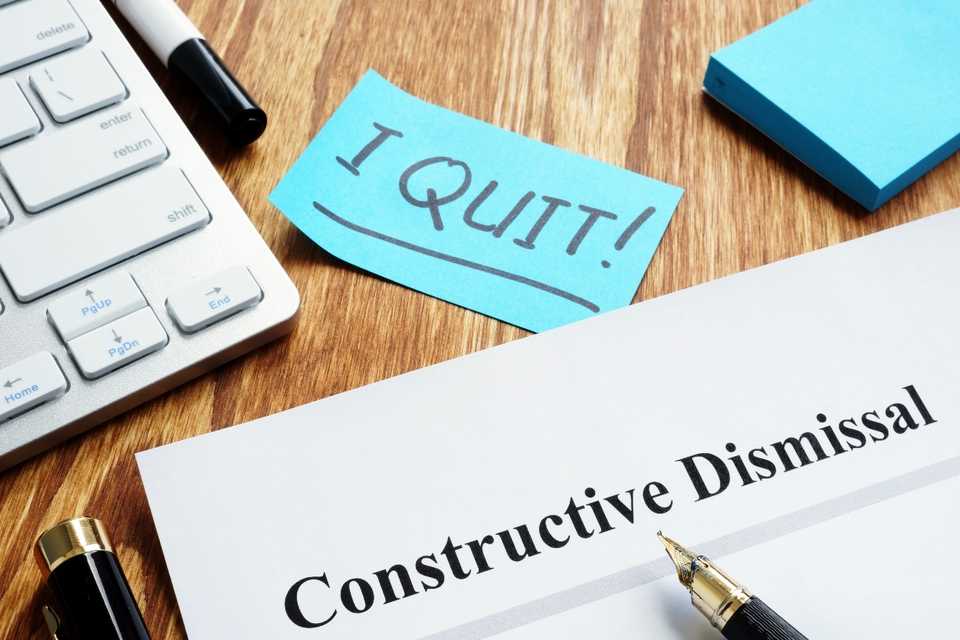With recent political and social developments regarding inclusion, diversity, and equity, and movements calling for racial justice and reconciliation, the landscape for workplace harassment and discrimination is now under increased focus.
Workplace harassment in any shape or form should never be tolerated. Every employer has specific obligations defined by Ontario’s Occupational Health and Safety Act(OHSA) to prevent or handle workplace harassment.

Workplace harassment occurs when a person engages in a course of irritating or displeasing behaviour or comments against an employee in a workplace which can be reasonably ascertained to be unwelcome. It also includes sexual harassment at work.
If you are experiencing workplace harassment, you should act immediately by speaking to an employment lawyer. In doing so, you are protecting yourself and ensuring it stops happening to you or anyone else.
Learn more about workplace harassment and what you need to do to stop it from happening to you.
You can also use our short online form, free of charge, to connect with experienced harassment lawyers near you.
What are the types of workplace harassment?

Workplace harassment occurs in different types. Below are examples:
- Making jokes or offensive comments
- Aggressive behavior or bullying
- Staring inappropriately
- Sexual harassment
- Making fun of a worker or excluding a worker due to his gender identity
Workplace harassment does not include reasonable actions taken by a manager for purposes of managing the workplace.
What should you do if you are being harassed at work?

If you are the target of workplace harassment, you must inform your manager, supervisor, or any person designated by the employer. If you belong to a worker’s union, you can also inform your union representative.
It is also important to keep a detailed and written record of the following:
- Date, time, and place when you were harassed;
- A description of the behavior or comments made;
- The identity of the person who harassed you;
- Names of any witnesses to the incident.
Investigation of Workplace Harassment by Your Employer
Section 32.0.7 of the Occupational Health and Safety Act (OHSA) mandates an employer to make sure a proper investigation is conducted regarding any complaint of workplace harassment.
Whenever such a complaint is made, the employer must:
- Investigate promptly. The investigation must be completed as soon as possible within 90 days unless significant factors cause a delay (a witness is ill and not available, or in case of multiple witnesses and incidents).
- Conduct an impartial investigation. The complainant should not be directly under the supervision of the harasser.
- Keep it confidential. The incident as well as the people involved must be kept confidential unless such disclosure is required by law or to take corrective action at the workplace.
- Investigate thoroughly. The employer must make reasonable efforts to get statements from the alleged harasser, the complainant, and the witnesses involved. All pertinent documents must be gathered and reviewed.
The Code of Practice addressing Workplace Harassment provides a template for investigation to assist employers.
In general, the first step to dealing with workplace harassment is through your company. Report the problem to your manager or the Human Resources Department.
It is also advisable to speak to an employment lawyer during this process so you can get legal support for your complaint.
In case the employer fails to resolve the matter satisfactorily, you can consider taking legal remedies with help from your lawyer.
Employment Lawyers Know the Law
Employment lawyers know everything about employment law and can give you valuable support in your situation.
Since they focus on employment law, they can find a swift and fair solution to your workplace harassment issue. They will evaluate the facts and present you with your best options.
Is the harassment violating a protected ground?

The Ontario Human Rights Code provides protected grounds including sex, gender, disability, age, marital status, sexual orientation, place of origin, etc.
The Ontario Human Rightsoffers protection to all individuals during:
- Recruitment, training, and the job application process;
- Employee transfers, promotions, and apprenticeship terms;
- Dismissals, terminations, and layoffs.
Pay rates, codes of conduct, overtime, working hours, holiday pay, shift work, performance evaluation, and disciplinary measures also fall under its purview.
If you are experiencing harassment based on a protected ground, you can file a claim with the Human Rights Tribunal of Ontario (HRTO).
The HRTO provides opportunities for the parties to settle disputes via mediation. If mediation is not successful, a hearing will be held wherein the Tribunal can award damages for loss of dignity or lost wages.
For federal employees, a complaint can be submitted to the Canadian Human Rights Commission. The parties are also given the opportunity to settle through mediation.
If an agreement cannot be reached, the Commission reviews the claim and decides whether it should be dismissed or referred to the Canadian Human Rights Tribunal for a hearing . The Tribunal can also award compensation for lost wages or pain and suffering.
Severe Harassment and Constructive Dismissal
Workplace harassment can sometimes be so severe that it makes continued employment intolerable. It could result in constructive dismissal wherein the employee is forced to resign.
In such cases, the employee can sue the employer for constructive dismissal with a lawsuit.

Constructive dismissals as a result of harassment are difficult to prove but can be powerful for victims of severe workplace harassment. The test for constructive dismissal requires the employee to show that the employer behaved in such a way that any reasonable employee could not continue to work . A pattern of harassing behavior must be shown although one severe incident of harassment could be enough.
Damages for being in a toxic work environment

Is the situation at work so bad that you must quit due to harassment? You can claim damages for constructive dismissal.
Any employer who makes working conditions intolerable is considered to have created a toxic workplace. Constructive dismissal only applies where serious wrongful acts can be proven.
Stand-alone incidents are not considered as harassment unless they are grievous or horrific in nature. Usually, the wrongful behavior must be repeated or persistent.
Proving Workplace Harassment
To prove workplace harassment and sue for damages, an employee must fulfill the following test:
- Was the conduct of the employer towards the employee outrageous?
- Did the employer intend to cause emotional stress or did they have a reckless disregard for causing the employee to suffer emotional stress?
- Did the employee suffer from severe or extreme emotional distress?
- Was the outrageous conduct of the employer the actual and proximate cause of the emotional distress?
It must be understood that a worker cannot file a claim for workplace harassment just because his manager is mean to him. The conduct must be so severe that it causes actual mental distress to qualify as harassment.
An experienced employment lawyer can help determine if you have grounds for claiming workplace harassment. He can prove your case and find your best recourse for damages .
Fill out the form on this page to connect with reputable employment lawyers, free of charge.
Understanding the Tort of Harassment: Suing an Employer
Ontario employers today face a greater risk of litigation from employees who experienced workplace harassment.
Tort Law offers compensation to individuals who are injured, physically or mentally , by the wrongdoing of others due to negligence or intention. It is concerned primarily with situations wherein a person does harm to another.

There have been cases that support the contention that workplace harassment causes mental injury. For instance, the case of Boucher vs. Wal-Mart Canada wherein the court found that the supervisor humiliated and demeaned the complainant continuously for 6 months was outrageous behavior. The court awarded damages of $410,000.
In addition to tort action, statutory remedies are also available to employees under the OHSA against the employer for his failure to maintain a harassment-free workplace.
Compensation for Workplace Harassment in Ontario
In recent years, Ontario courts have awarded more substantial damages to victims of workplace harassment.
For instance, the Ontario Court confirmed in 2021 that the contractual limitations on termination are not applicable if the employee was subjected to harassment. An employer cannot reply on the termination clause that limits an employee’s damages for termination without cause if the employee was in a toxic workplace.

In a 2022 case, the jury awarded a victim of workplace harassment punitive damages amounting to C$1.5 Million, the largest ever in the history of Canada, and an additional C$40,000 in aggravated damages.
While money can never compensate for the anguish and pain, compensation can facilitate a victim’s recovery from the ordeal.
Speak to an employment lawyer to help you file a lawsuit for workplace harassment.
Fill out our short online form today to receive offers from employment lawyers with a solid track record for workplace harassment claims.
How much does an employment lawyer cost?
An employment lawyer can charge from $250 an hour to $800++ an hour.
Several factors can influence the cost of a lawyer’s services. More experienced lawyers are likely to charge higher fees . Your location in Ontario will also impact a lawyer’s rate as fees tend to be higher in bigger cities like Toronto.
While the cost is an important consideration when choosing a lawyer, it should not be your main priority.
Your legal expenses will also depend on what you need your employment lawyer to do. He will charge fees based on the length of time he works on your case . If he only needs to send a demand letter, it could take only a few hours whereas a trial will take longer.
You can compare multiple employment lawyers to find the right one to represent you! Just fill out our online request form to save time and money.
Find an Employment Lawyer for Workplace Harassment
You can also claim damages from workplace harassment under your employer’s Workplace Harassment policy. The complaint must be investigated properly or the Ministry of Labor can order the employer to hire a qualified investigator at the company’s expense.

You must know your rights under the law and your legal recourse for workplace harassment.
Find the right employment lawyer in Ontario to take the best course of action on your behalf and fight for your rights.
Fill out the form below, free of charge, and get connected to top employment lawyers in Ottawa, Toronto, Greater Sudbury, Mississauga, Richmond Hill, or wherever you are in Ontario!